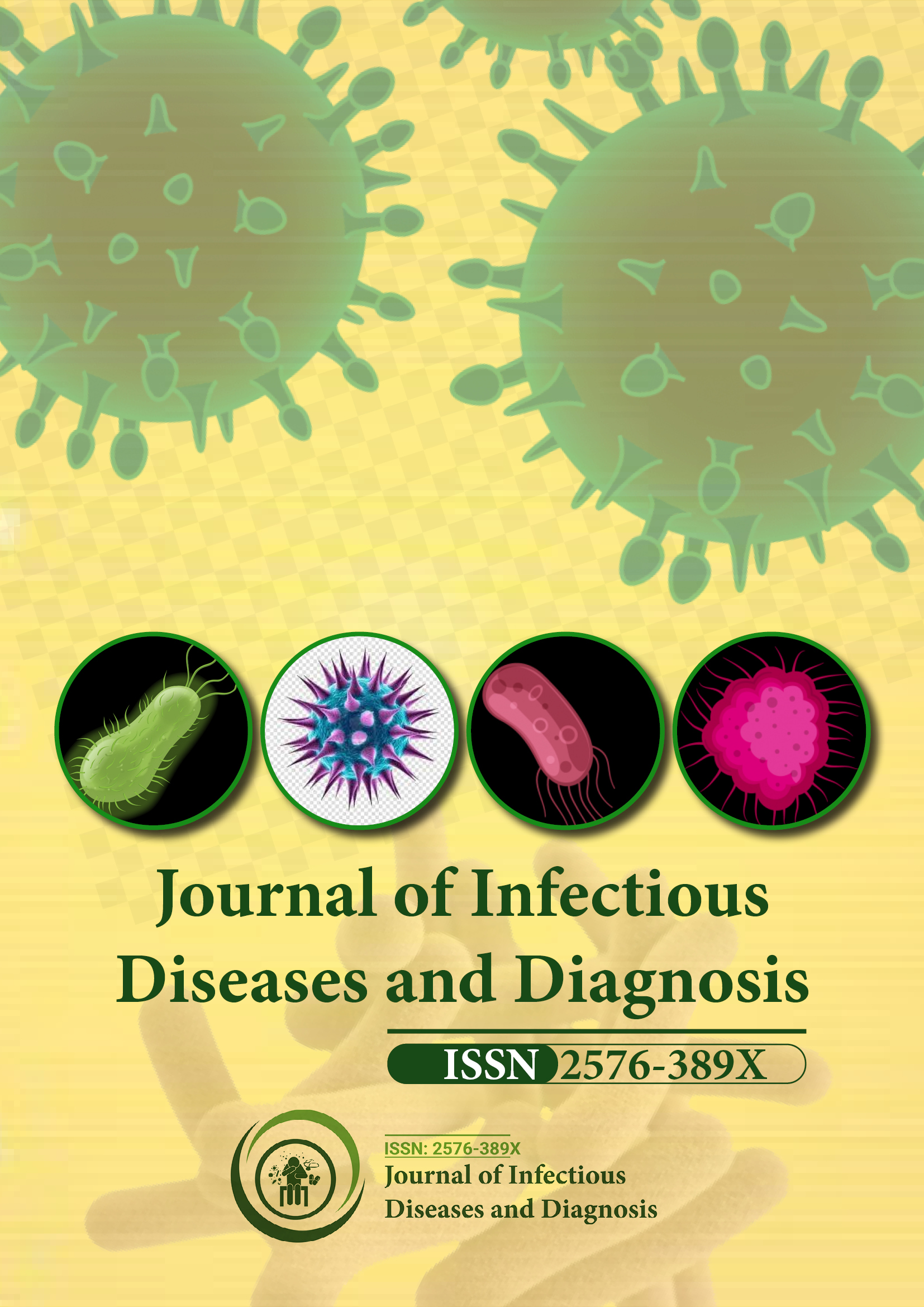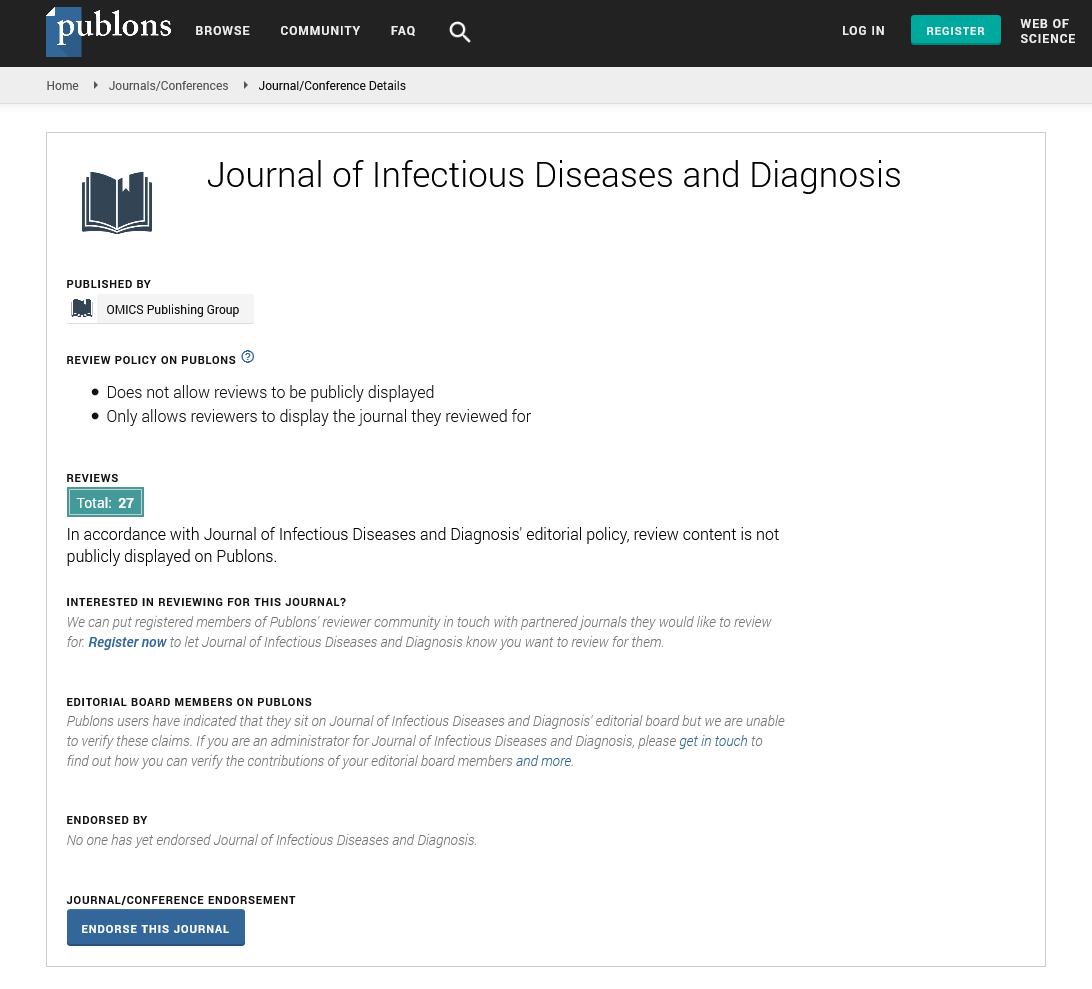Indexed In
- RefSeek
- Hamdard University
- EBSCO A-Z
- Publons
- Euro Pub
- Google Scholar
Useful Links
Share This Page
Journal Flyer

Open Access Journals
- Agri and Aquaculture
- Biochemistry
- Bioinformatics & Systems Biology
- Business & Management
- Chemistry
- Clinical Sciences
- Engineering
- Food & Nutrition
- General Science
- Genetics & Molecular Biology
- Immunology & Microbiology
- Medical Sciences
- Neuroscience & Psychology
- Nursing & Health Care
- Pharmaceutical Sciences
Perspective - (2022) Volume 7, Issue 6
World-Wide Regional Incidence of Infectious Diseases over COVID-19 Mortality
Caulley Lisa*Received: 02-Nov-2022, Manuscript No. JIDD-22-19289; Editor assigned: 04-Nov-2022, Pre QC No. JIDD-22-19289 (PQ); Reviewed: 22-Nov-2022, QC No. JIDD-22-19289; Revised: 29-Nov-2022, Manuscript No. JIDD-22-19289 (R); Published: 02-Dec-2022, DOI: 10.35248/2576-389X.22.07.189
About the Study
The World Health Organization (WHO) proclaimed COVID-19, caused by SARS-CoV-2, a pandemic on March 11, 2020, resulting in 379 million illnesses and 4.26 million deaths. The number of reported cases and deaths varied by continent and country. Various reasons for differences in cases and risk factors for COVID-19 outcome were investigated, including demographic features, comorbidities, socioeconomic and environmental factors, vaccination rates, acquired immunity by SARS-CoV-2 infections or vaccinations, occurrence of SARSCoV- 2 variants, and governmental measures such as social distancing, lock downs, masks, contact tracing, and treatment options availability. COVID-19 incidence and death were substantially linked with demographic characteristics such as socioeconomic level, household composition, environmental factors, and race/ethnicity. It was unclear if COVID-19 result disparities were due by biological or socioeconomic factors.
Trained innate immunity may influence COVID-19 resistance and consequently the outcome of COVID-19 cases, according to new research. The concept of trained innate immunity with heterologous protection against (secondary) infections is based on past infections, contact with microbes (including Bacillus Calmette-Guerin (BCG)) or their structures like as lipopolysaccharides and β-D-glucans. The concept that trained innate immunity modulates COVID-19 outcome was substantiated by a negative correlation between BCG vaccination rates and COVID-19 mortality.
If, as previously explained, trained immunity confers some degree of resistance to a severe course of COVID-19, and then nations with a high prevalence of various infectious diseases endemic in their population should have less COVID-19 mortality than those with no such prior burden of infection. We expected that chronic exposure to infectious illnesses will increase resistance to COVID-19 and regulate negative effects. We wanted to see if the local burden of infectious illnesses, as measured by comparable surrogate factors, as well as paediatric mortality, age, and vaccination rates, influenced the outcome of COVID-19. Overall, the higher the death toll from numerous infectious diseases, as well as chronic respiratory disease, was in a given country before to the commencement of the COVID-19 pandemic, the lower the number of COVID-19 deaths during the pandemic. These associations between COVID-19 mortality on the one hand and several measures of prior illness load on the other were all highly significant.
The unfavorable connection between respiratory illness death and COVID-19 death may require special study. Respiratory diseases in our data collection included WHO-defined diseases of the airways and other lung structures such as Chronic Obstructive Pulmonary Disease (COPD), asthma, occupational lung diseases, and pulmonary hypertension. Age was found to be positively linked with COVID-19 fatalities. Aside from repeated lower respiratory infections throughout childhood, tobacco smoke, air pollution, occupational exposure to chemicals and dusts are all cited as risk factors for chronic respiratory disorders. Though patients with chronic pulmonary disease are thought to be at a higher risk for severe COVID-19, in our data, death from all pulmonary disease was inversely related to COVID-19 deaths on a country-by-country basis.
There are numerous possibilities that could explain the substantial negative relationships between infectious illness load and COVID-19 mortality. Initially, there is a strong correlation between each of the illness burden metrics and median age. The unequivocal negative correlations between disease burden measures on one side and median age on the other show that frequent and early mortality reduces median age in a specific population. Because age is one of the most important risk factors for COVID-19 mortality, a younger population may make a country more resistant to a deadly course of COVID-19. Second, persons who have survived dangerous exposures to a variety of infectious infections until adulthood may be more resistant to COVID-19 infection. As a third hypothesis, repeated exposure to infectious pathogens may induce non-specific trained immunity, hence reducing the severity of a second COVID-19 infection.
According to univariable analysis, a high vaccination rate appears to correspond with a large proportion of COVID-19 deaths worldwide. When median age was also considered, COVID-19 deaths were positively connected with rising median age of the population, but negatively with vaccination rate per country. Clearly, this reflects a global trend, with a greater rollout of vaccination in developed countries with an ageing population, which are more susceptible to severe, and fatal COVID-19 disease, and low vaccination rates in countries with a high burden of other infectious diseases and a young population, which are more resistant to COVID-19 fatalities.
In line with earlier findings, we discovered that immunization protected against COVID-19 death, as local vaccination rates were negatively related to COVID-19 deaths in a multivariable manner. Because these data are extensively utilized, we centered our research on mortality statistics from a single source, namely Our World in Data. Furthermore, sticking to a single data base prevents arbitrary data modifications, which would occur, for example, if we selected some data values for specific countries from another source. We recognize that data may be influenced by reporting bias, but determining which data are and are not would create the risk of arbitrary data management. For the same reason, we did not confine our research to a specific subset of nations with apparently excellent data reliability; as such a selection could distort the results.
To the best of our knowledge, this is the first study to examine the possible impact of local infectious illness load on eventual COVID-19 mortality in a country-by-country analysis on a worldwide scale. There are, however, many constraints that must be considered. The publicly accessible data used in this study are mostly based on reports from the respective countries' agencies. Furthermore, COVID-19 mortality has not been studied in a tiered manner taking into account different age groups.
The former will have an impact on infectious disease burden prior to the commencement of the COVID-19 pandemic, and the latter may have an impact on the pandemic's course. The statistically significant inverse association of infectious illness burden on the one hand and COVID-19 mortality on the other, however, indicates a substantial dependency of both parameters. It calls for additional research into the underlying processes of this association.
Citation: Lisa C (2022 World-Wide Regional Incidence of Infectious Diseases over COVID-19 Mortality. J Infect Dis Diagn. 7:189.
Copyright: © 2022 Lisa C. This is an open-access article distributed under the terms of the Creative Commons Attribution License, which permits unrestricted use, distribution, and reproduction in any medium, provided the original author and source are credited.

